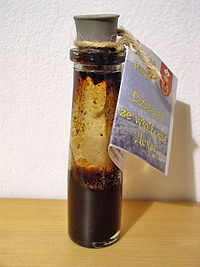
Photo from wikipedia
Abstract Pine resin is a highly valuable and sought-after non-timber forest product with multiple uses in many industrial sectors. Maritime pine (Pinus pinaster Ait.) is the main tapped species in… Click to show full abstract
Abstract Pine resin is a highly valuable and sought-after non-timber forest product with multiple uses in many industrial sectors. Maritime pine (Pinus pinaster Ait.) is the main tapped species in Europe, where resin tapping activities are concentrated in only a few specific Mediterranean regions. Although maritime pine also occupies vast extensions under Atlantic climates, the resin tapping potential of these forests remains unexplored. The objectives of this study were to determine the main factors driving resin yield under Atlantic conditions and to adapt extraction practices to these regions. Resin yield was assessed in two naturally regenerated maritime pine forests in NW Spain. The effects of tree age, inter-tree competition, dendrometry, seasonality and wounding time on resin production were tested. The feasibility of a simple and rapid microtapping procedure to predict resin yield was also assessed. Tree age was identified as the main factor driving resin production, which increased considerably with tree age. Tree slenderness, tree size and inter-tree competition also significantly influenced resin production, although the effects were lower and likely mediated by age variation. Resin yield followed marked seasonal patterns, with maximum production in late summer and minimum production in winter. Resin flow decreased rapidly with time after wounding. More than 95 % of resin yield flowed in the first week after trees were wounded. The proposed microtapping procedure, which estimates resin flow from small wounds in just a few days, was shown to be a useful and reliable tool both for phenotyping and to predict resin yield in new stands. The results confirm the high potential for resin tapping in Atlantic maritime pine forests, although tapping should be restricted to stands older than 30 years and a season should be delimited for this activity in the region studied. Additionally, the periodicity of grooves (typically fortnightly) may need to be increased.
Journal Title: Industrial Crops and Products
Year Published: 2020
Link to full text (if available)
Share on Social Media: Sign Up to like & get
recommendations!